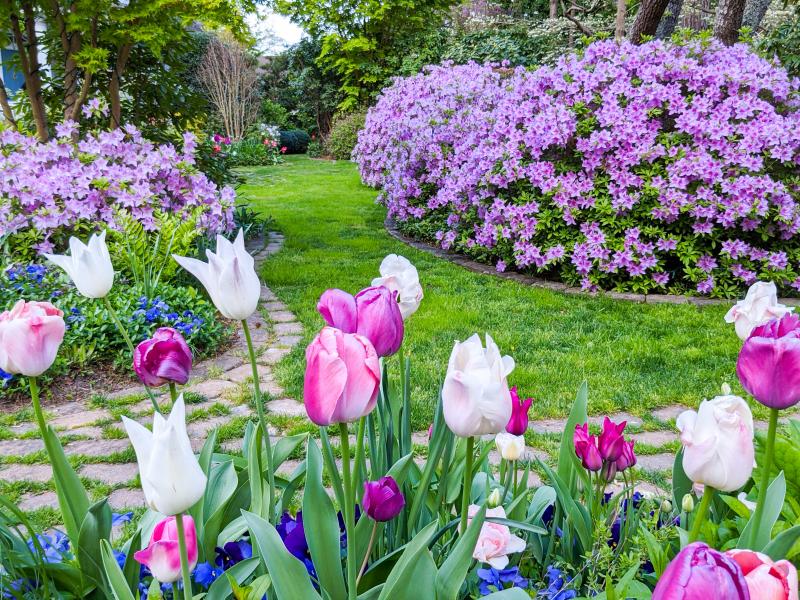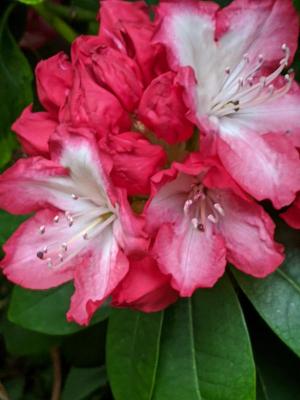Everyone loves flowers. They bring a bland green garden alive with color. Most people put flowering plants in their garden as the major features for their enjoyment, and gardeners can maximize their efforts by planting for a succession of bloom. When one flowering species is going off, another is coming into bloom to provide the garden with a constant change in visual interest.
Mill Pond Garden, a small, private botanical garden at 31401 Melloy Court, Lewes, on Red Mill Pond, looks quite different every time it has an Open Day, with different things in bloom in order to provide examples of reliable succession planting for Cape Region gardens.
Mill Pond Garden will celebrate Mother’s Day with tours available from 10 a.m. to 12:30 p.m., Sunday, May 9, showing a peak of succession blooming. Subscribe free and purchase tickets at millpondgaren.com. The garden will display the current succession of flowering plants in the peak of mid-spring including prize roses, native rhododendrons, clematis, iris, native trilliums, pansies, native woodland phlox, tulips, weigela, and flowering vines. Visitors may see basking pond turtles, koi fish, waterfowl, land birds, frogs, and occasionally the resident osprey, bald eagle, beaver, or pond otter.
For rhododendrons, a Cape Region succession planting can include varieties that flower as early as the last week of March including Rhododendron mucronrolatum Amethystinum, a favorite at Mount Cuba garden in northern Delaware; then PJM types, Olga Mezitt, Karen (a favorite for good fall color), President Roosevelt, poukhanense azaleas, and Hinode Geri. The next in succession for early to late May would include Girard’s hybrid azaleas, catawbiense rhododendrons, Boursault rhododendron, English Roseum, Percy Wiseman, Solidarity, Gomer Waterer, and the sensational Anna Rose Whitney. The next in succession from late May through early June would include Nova Zembla, America, Purpurea, and later-blooming Chinoides. Mill Pond Garden does not recommend any of the mid- to late-season blooming deciduous azaleas because they get petal blight, a disfigurement and maintenance nightmare. The new repeat-blooming evergreen azaleas are highly resistant to petal blight, so they can be recommended as later-blooming azaleas from early May to early June, repeating in late September. Note these repeat azaleas like full sun to bloom well. They can grow quite large, so give them space.
Azaleas are a category of rhododendron differentiated by smaller flowers and leaves but, genetically, they belong to the same genus as the large-leaved ones. Each rhododendron or azalea might bloom about a week or two depending on temperatures. There are over 900 species of rhododendron from tiny to tree size. Mill Pond Garden recommends only ones found to grow well here.
All the genus rhododendron likes well-drained, acidic, humus-rich soil. Most tolerate part shade to mostly sun. All like acidic organic fertilizer in late winter, and/or garden compost of leaves, or horse manure which is pH 6.8. Never fertilize later, as it can cause problems or even kill the shrub. If leaf color is pale, it means the soil is too alkaline for iron to make the dark-green chlorophyl. This problem can be corrected with garden sulfur powder and/or a dressing of peat moss, pH 3.0, very acidic.
Succession of bloom planting can be done for the whole garden and for many species, not just for spring azaleas and rhododendrons. With some planning and good choices, a garden can provide happy color all year long, even in winter! A beautiful garden with good trees and flowers in colors complimentary to each other and the house increases not only the enjoyment, but also the value of a house by up to 20 percent, a practical investment.
























































